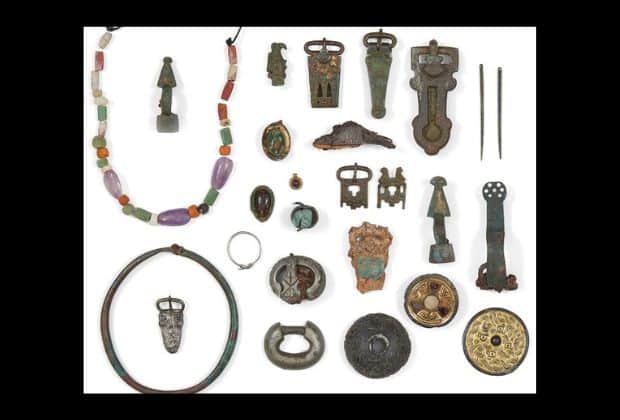
More than 1,700 Anglo-Saxon artefacts which were discovered in Ramsgate are to be sold at auction.
The ‘Ozengell Hoard’ comes from a cemetery, probable 6th century in date, that was was uncovered at Ozengell, during the construction of the Ramsgate-Deal Railway in 1845. A number of graves were found cut into the chalk and a further number, possibly as many as 100 ,were said to have been destroyed before the area was investigated.
A wide array of grave goods was reported including metal artefacts such as clench bolts (possibly indicating a coffin), keys, spearheads, coins, samian wares, and brooches dating to the 5th century.
One grave had a beaker near the head; and others were reported to contain Samian ware in a similar position.. Two graves held three bodies, however others were individual and represented male and female. One grave produced a coin of Justianian dating to 527-65 and another produced 2 brooches of the 5th century.
A Roman lead coffin and another Roman grave were reported in the area in subsequent years.
In 1966 workmen discovered 7 graves and a further 87 graves were revealed during excavations near the Lord of the Manor in 1977, with a total of 192 graves revealed during excavations between 1977-1981. The graves were disturbed in antiquity but many artefacts remained, mainly dating to the 7th Century A.D., with some from the 6th Century A.D
Cropmarks of over 100 probable graves, aligned east – west and including a small penannular ditch with a central grave had been recorded in 1974.
There was also evidence of internal structures and wickerwork fences within some of the graves. Many of the finds from this site are thought to be in the British Museum.
The finds from the excavations between 1977-1981 were placed on loan to the Powell-Cotton Museum at Quex Park from 1983-2010. They were then returned to land owner David Steed.
The artefacts are now going under the hammer with Roseberys. The collection comprises over 1,700 artefacts, with disc brooches, inlaid pendants of silver and gold, glass and other beads, iron weaponry and implements, buckles, bracelets and fibulae, shield bosses, a pyramid mount and pommel, carved bone artefacts, pottery and glass vessels.
Artefacts in the collection were conserved decades ago, some by the Ancient Monuments Laboratory and others by the Institute of Archaeology. Four important glass finds from this hoard were sold by Christie’s in 2011.
The collection is being offered as a single lot in the auction house’s Antiquities, Islamic and Indian Arts auction with an estimate of £12,000-15,000. The auction will take place on Friday 28 October, at 10am.
Although involved in the digs the Isle of Thanet Archaeological Society (IOTAS) does not own the artefacts and the Society cannot and says it would not put them up for sale. Under Charity Commission regulations, a non-incorporated charity such as IOTAS is not permitted to own or sell property.
The Kent Archaeological Society has signalled an intention to bid for the collection.
Via facebook KAS said: “This is an important collection which fits into the Society’s existing Anglo Saxon collections and it is important that this group remains intact and available for research and future generations.”

